↑ The Darknet: illegal guns, drugs, pornography, sex trafficking, and assassins.
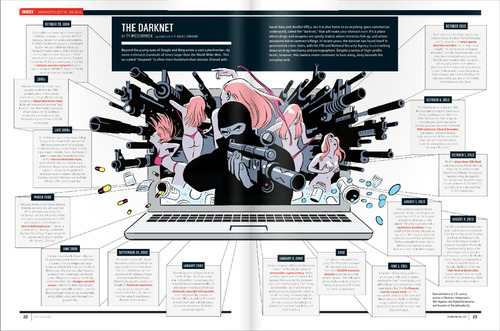 ↑ The article as seen in print.
↑ The article as seen in print.
↑ Unused sketch.
Art Direction: Lindsay Ballant
↑ The Darknet: illegal guns, drugs, pornography, sex trafficking, and assassins.
 ↑ The article as seen in print.
↑ The article as seen in print.
↑ Unused sketch.
Art Direction: Lindsay Ballant
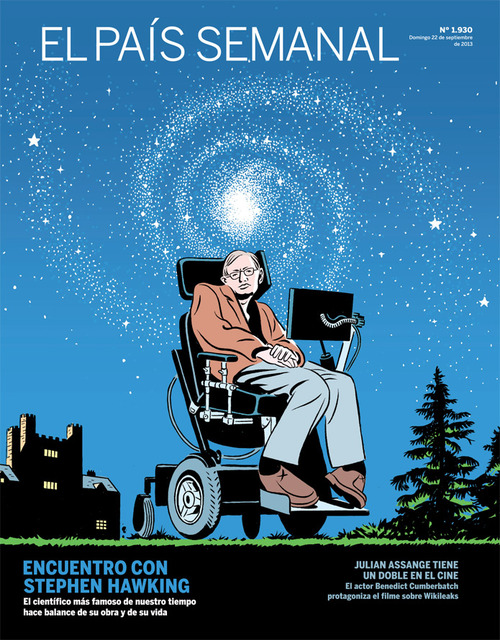 ↑ Art Director Paloma Lorenzo recently commissioned this portrait of Stephen Hawking for the cover the cover of El País Semanal, the Spanish newspaper's weekend magazine supplement.
↑ Art Director Paloma Lorenzo recently commissioned this portrait of Stephen Hawking for the cover the cover of El País Semanal, the Spanish newspaper's weekend magazine supplement.
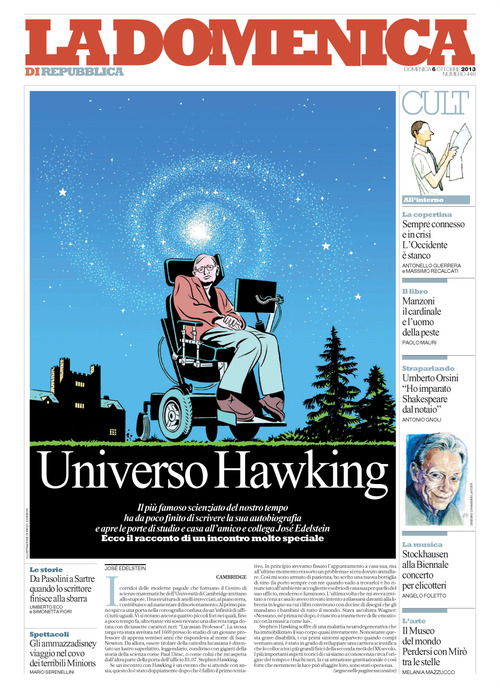 ↑ The image was later purchased by La Reppublica for the Italian translation of Jose Edelstein's article.
↑ The image was later purchased by La Reppublica for the Italian translation of Jose Edelstein's article.
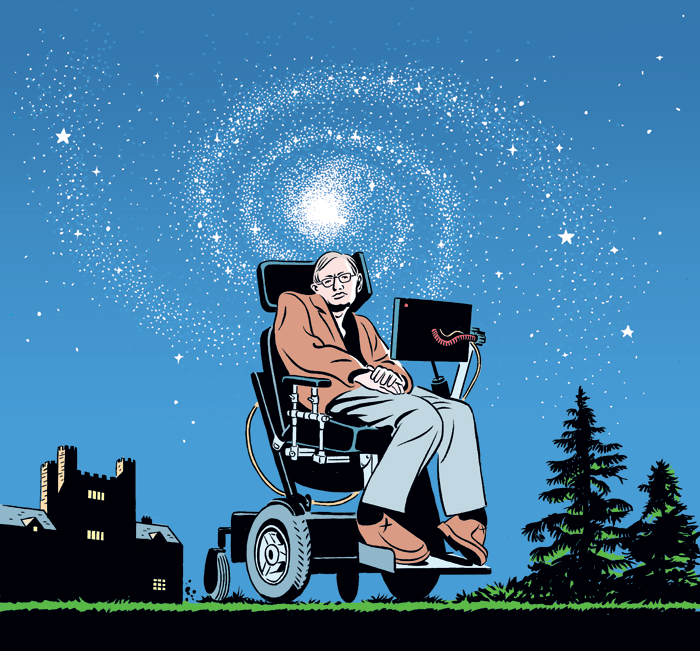
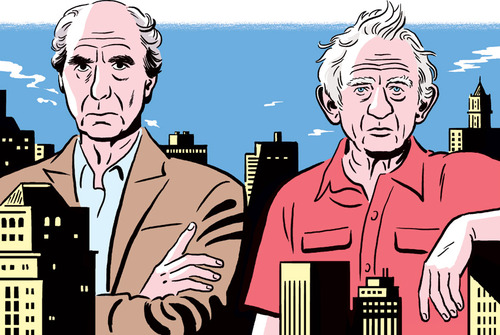 ↑ Philip Roth and Norman Mailer for the New York Times Sunday Book Review. ↓
↑ Philip Roth and Norman Mailer for the New York Times Sunday Book Review. ↓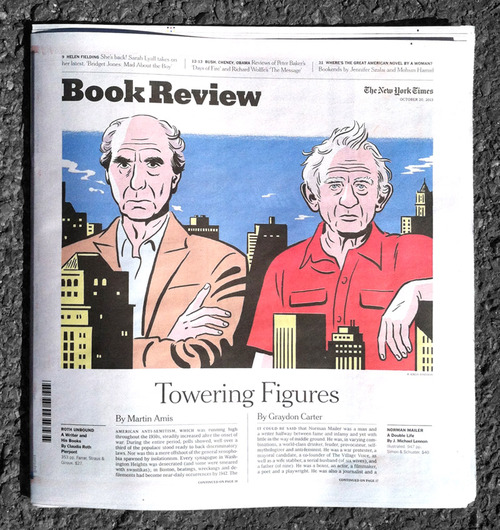
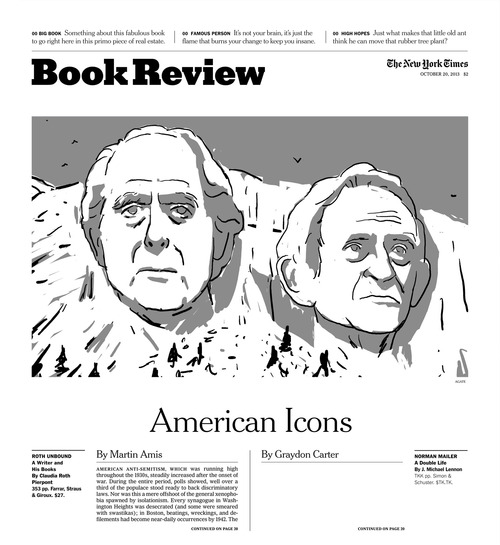 ↑ Unused sketch with an early headline which was ultimately scrapped.
↑ Unused sketch with an early headline which was ultimately scrapped.
↑ Columnists for the New York Times Sunday Book Review's new weekly series, "Bookends."↓

Art Direction: Nicholas Blechman
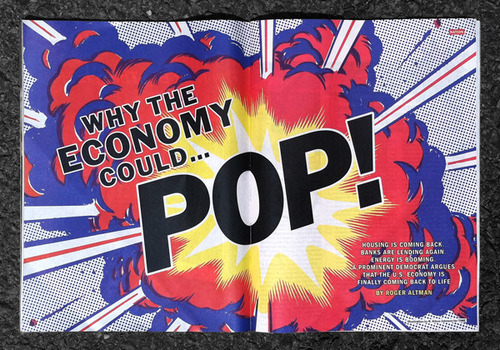 ↑ Art director April Bell commissioned this Roy Lichtenstein-inspired feature for Time magazine.
↑ Art director April Bell commissioned this Roy Lichtenstein-inspired feature for Time magazine.
Last summer, I was commissioned to design a Zoo York skateboard deck for pro skater Chaz Ortiz. The art directors provided strict parameters: a bear smashing a car in front of the Chicago Theater with Ortiz's name on the marquee. Of course, the graphic also had to fit within the strange shape of a modern skateboard, remain legible with trucks and wheels installed, and incorporate a limited, silkscreen-friendly pallet.
↑ Production model. The manufacturer ultimately chose a dark grey wood treatment.
This humble project marked a career milestone for me. I've now designed a skateboard deck, drawn a Marvel comic book, and published comics starring my own characters. All three of the big dreams I had as a ten year old have come true. Now on to those pesky dreams of a thirty year-old...
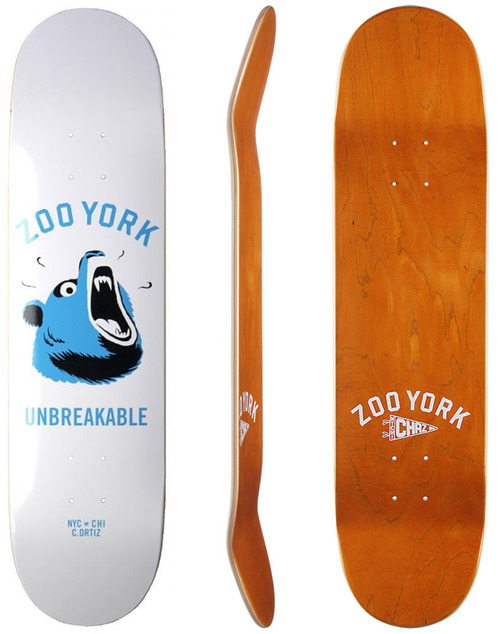 ↑ Production model #2. A second deck with just the bears head was also produced.
↑ Production model #2. A second deck with just the bears head was also produced.
I had fun aping my childhood heroes, Jim Phillips and Steve Nazar on this project. Phillip's solid draftsmanship, color, and text design hold up remarkably well almost thirty years later.
↑ Unused T-shirt design.
Zoo York eventually asked me to rework the deck graphic for a T-shirt. Unfortunately, this shirt probably won't see production. However, the "bear head" graphic was printed in a variety of styles and colors as part of Zoo York's 2013 Summer and Fall lines.
 ↑ One example of apparel produced with the bear graphic.
↑ One example of apparel produced with the bear graphic.
Art Direction: Craig Hein, Robert Lim
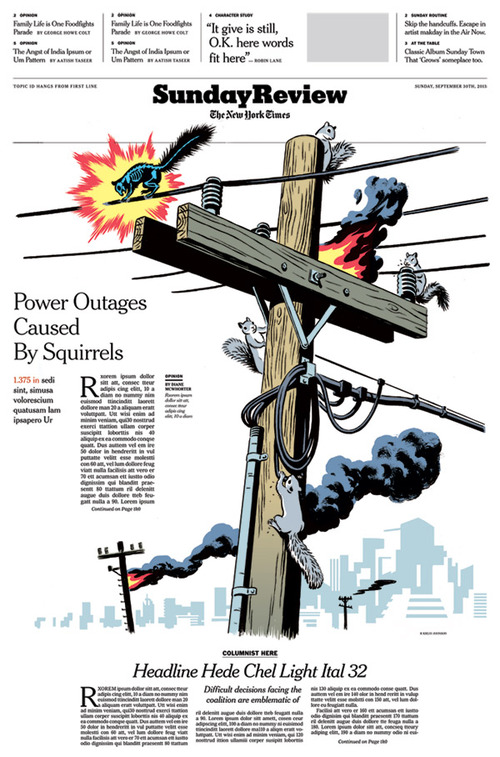 ↑ New York Times Sunday Review cover (dummy text provided by the Times.)
↑ New York Times Sunday Review cover (dummy text provided by the Times.)
Thank you to art director Aviva Michaelov who passed along a fun piece about power outages caused by squirrels.
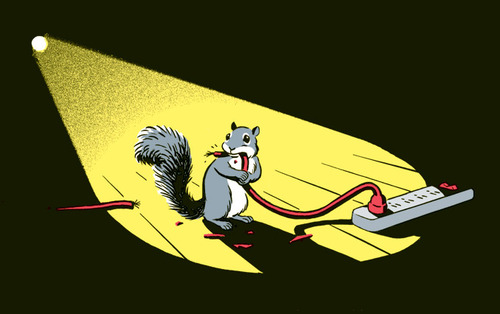 ↑ Spot illustration accompanying the article.
↑ Spot illustration accompanying the article.
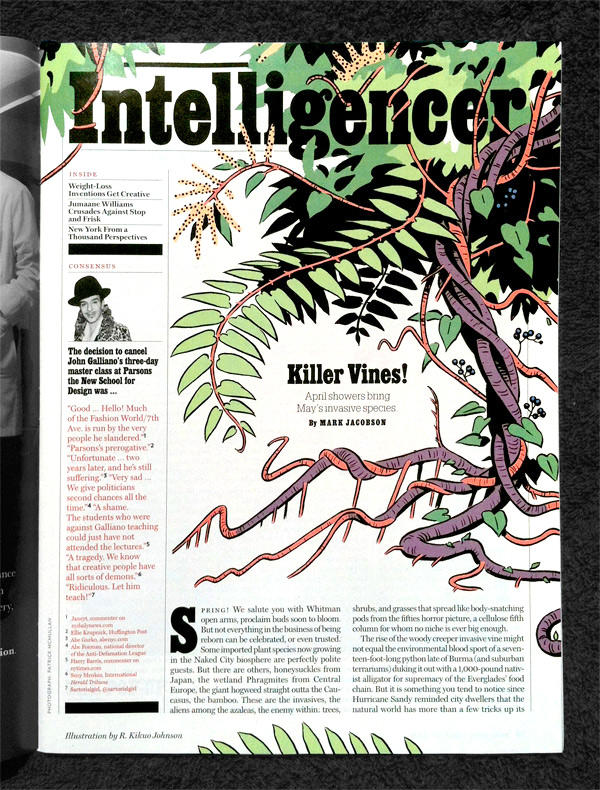 ↑ New York Magazine article about invasive vines from earlier this summer. Another "live-edge" illustration on a similar theme.
↑ New York Magazine article about invasive vines from earlier this summer. Another "live-edge" illustration on a similar theme.
Art direction: Karishma Sheth.
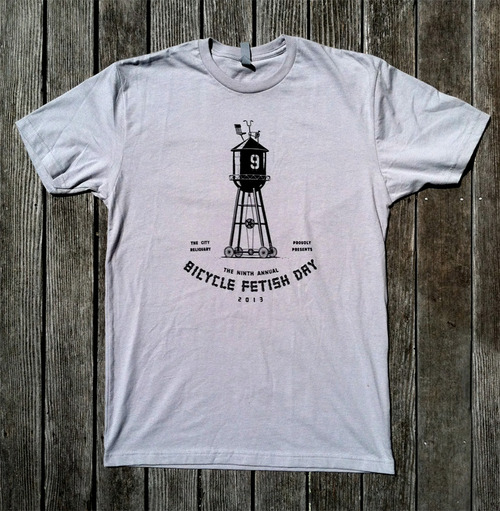 ↑ T-shirt for 2013's 9th annual Bicycle Fetish Day commissioned by my friends at the The City Reliquary.
↑ T-shirt for 2013's 9th annual Bicycle Fetish Day commissioned by my friends at the The City Reliquary.
↑ All hand lettering with an original "bike chain" font.
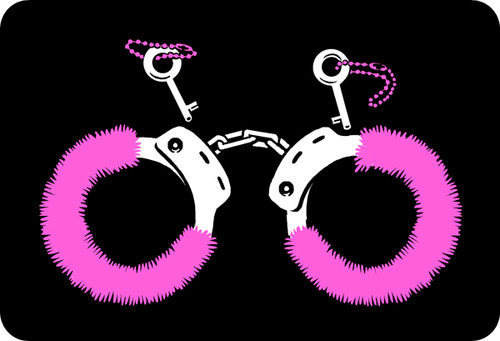 ↑ Unused Bicycle Fetish graphic. This design wasn't quite family-friendly enough for the event.
↑ Unused Bicycle Fetish graphic. This design wasn't quite family-friendly enough for the event.
 ↑ Sketch.
↑ Sketch.
 ↑ Henry David Thoreau and his small cabin at Walden Pond.
↑ Henry David Thoreau and his small cabin at Walden Pond.
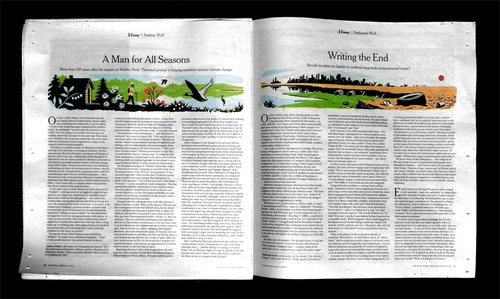 ↑ Two separate articles reviewing books on climate change. Art Director Nicholas Blechman proposed two illustrations that combine to suggest a single narrative.
↑ Two separate articles reviewing books on climate change. Art Director Nicholas Blechman proposed two illustrations that combine to suggest a single narrative.
 ↑ The Dish Network founder Charlie Ergen (center) is the subject of the Hollywood Reporter's cover feature this week. Clockwise from left: Time Warner's Jeff Bewkes, NBC Universal's Steve Burke, Disney's Robert Iger, News Corp.'s Rupert Murdoch and CBS' Leslie Moonves are threatened by Ergen and Dish's ad-skipping service Hopper.
↑ The Dish Network founder Charlie Ergen (center) is the subject of the Hollywood Reporter's cover feature this week. Clockwise from left: Time Warner's Jeff Bewkes, NBC Universal's Steve Burke, Disney's Robert Iger, News Corp.'s Rupert Murdoch and CBS' Leslie Moonves are threatened by Ergen and Dish's ad-skipping service Hopper.
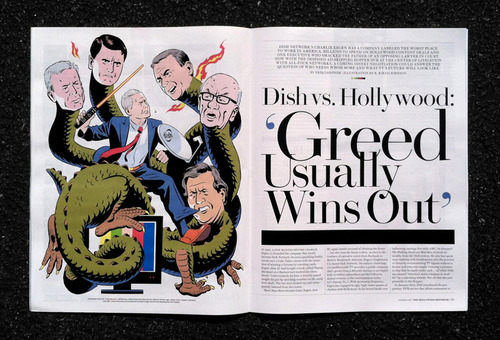 ↑ Art Direction: Shanti Marlar
↑ Art Direction: Shanti Marlar
 ↑ "Best Director." I did a few other small spot illustrations for the Hollywood Reporter earlier this year during Oscar season.
↑ "Best Director." I did a few other small spot illustrations for the Hollywood Reporter earlier this year during Oscar season.
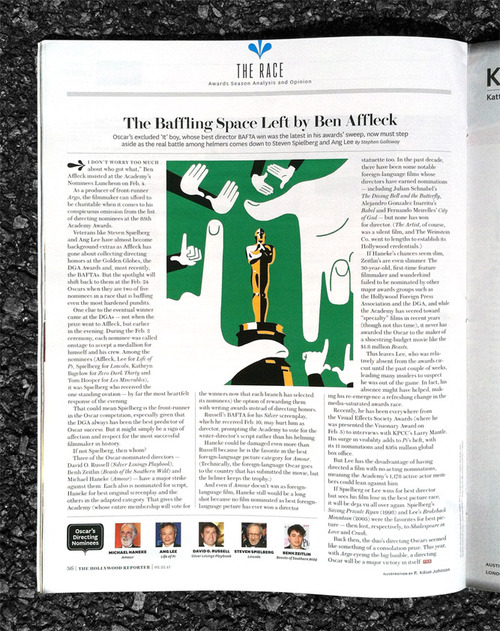 ↑ Due to an overabundance of red in this issue, Art director Kelsey Stefanson asked me to try a few different color options. I was happy to find this green and white version printed next to the headline, "The baffling space left by Ben Affleck." The white hands fortuitously seemed suggest Affleck's absence.
↑ Due to an overabundance of red in this issue, Art director Kelsey Stefanson asked me to try a few different color options. I was happy to find this green and white version printed next to the headline, "The baffling space left by Ben Affleck." The white hands fortuitously seemed suggest Affleck's absence.
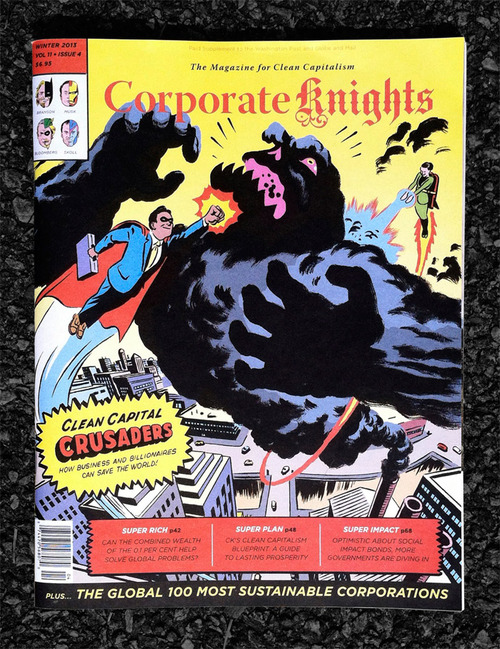 ↑ Superhero-themed cover to Corporate Knights #42. ↓
↑ Superhero-themed cover to Corporate Knights #42. ↓
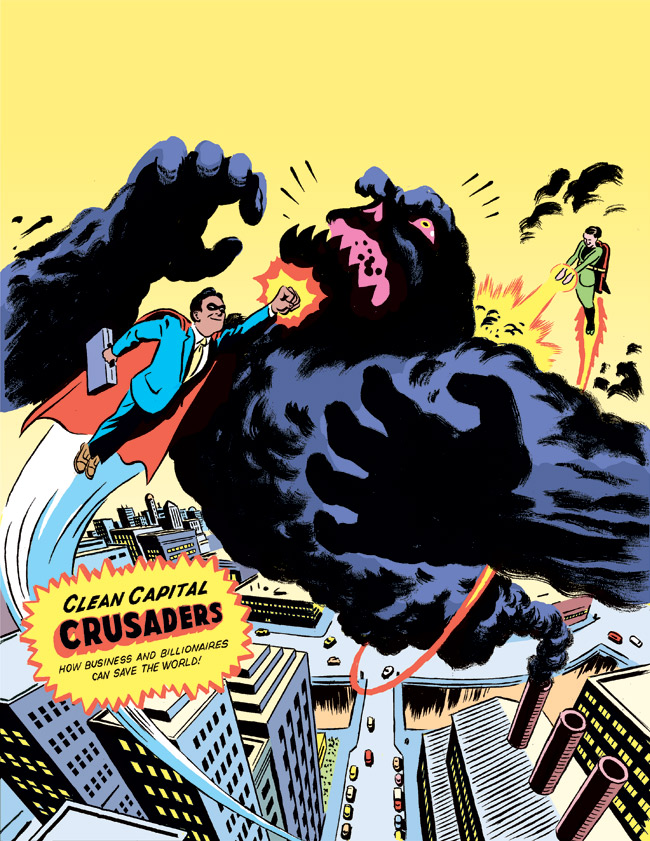
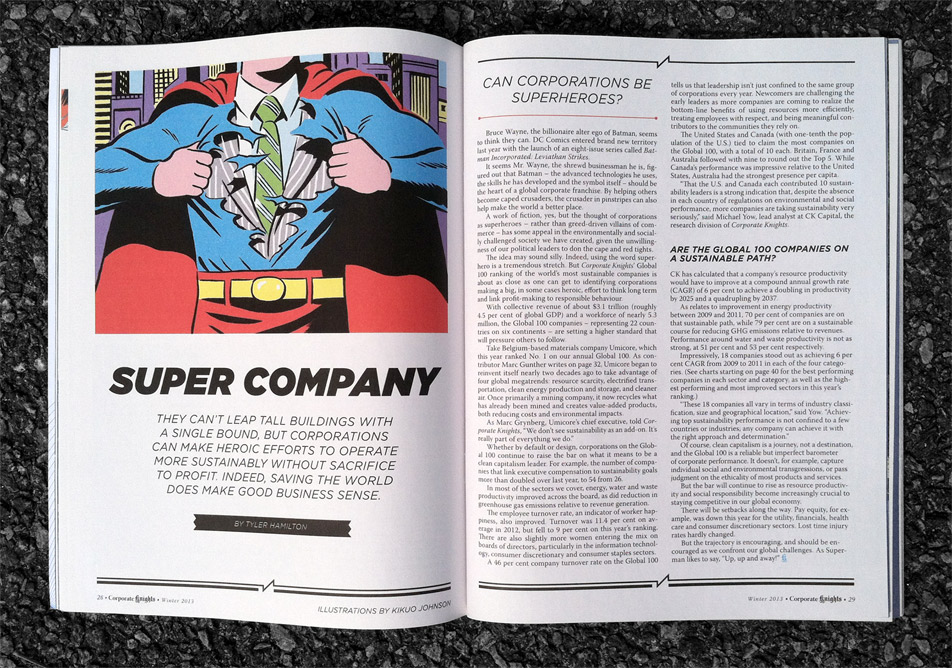 ↑ Interior feature, "Super company." ↓
↑ Interior feature, "Super company." ↓
↑ "The .01% can save the planet," featuring Sir Richard Branson as Batman, Jeff Skoll as Arch Angel, Michael Bloomberg as Green Arrow, and Elon Musk as Iron Man. ↓
Art Direction: Jack Dylan
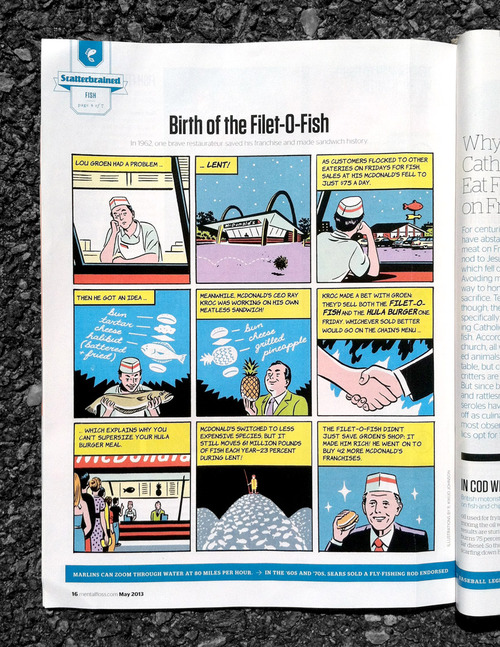 ↑ "The Birth of the Filet-O-Fish." Script: Mental Floss Magazine. Lent, 2013.
↑ "The Birth of the Filet-O-Fish." Script: Mental Floss Magazine. Lent, 2013.
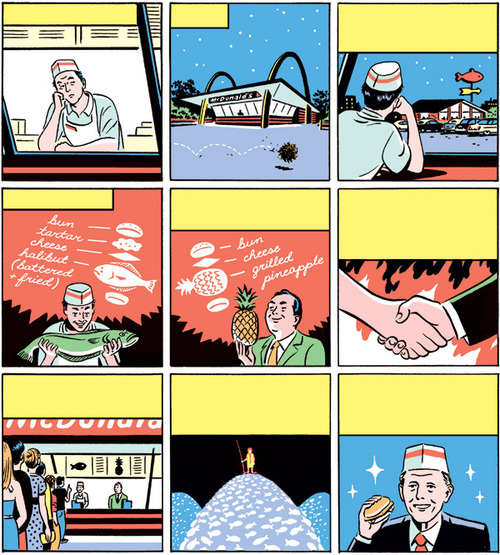 ↑ Unused red version. Art direction: Winslow Taft.
↑ Unused red version. Art direction: Winslow Taft.
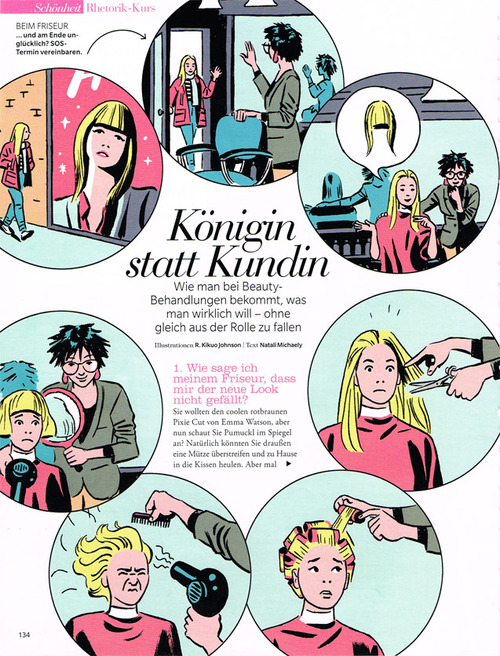 ↑ a 2011 feature in Myself Magazine. Art Direction: Caroline Caesar.
↑ a 2011 feature in Myself Magazine. Art Direction: Caroline Caesar.
I had the honor of creating the cover art for a new English edition of Junichiro Tanizaki's 1929 classic, Some Prefer Nettles.
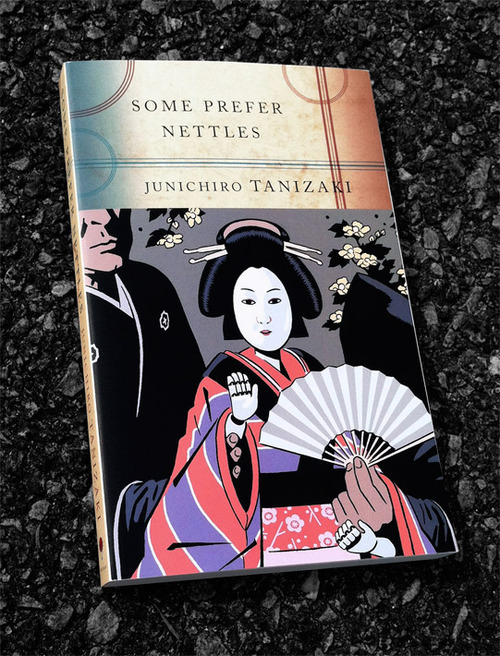 ↑ This edition is part of Random House's new Modern Japanese Classics series. The entire line shares the same title treatment designed by John Gall.
↑ This edition is part of Random House's new Modern Japanese Classics series. The entire line shares the same title treatment designed by John Gall.
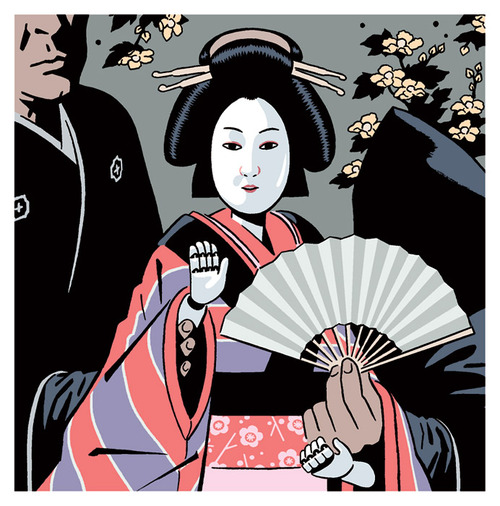 ↑ Bunraku, Japanese puppet theater, is central to the novel's theme.
↑ Bunraku, Japanese puppet theater, is central to the novel's theme.
Art direction: John Gall
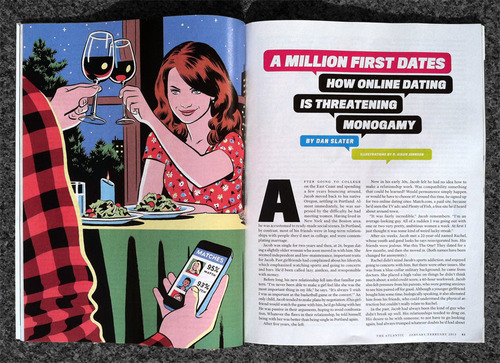 ↑ Atlantic Monthly feature on online dating.
↑ Atlantic Monthly feature on online dating.
 ↑ Finished spot illustrations. ↓
↑ Finished spot illustrations. ↓
![]() ↑ Unused digital sketch of a fly fishing date described in the article.
↑ Unused digital sketch of a fly fishing date described in the article.
Art Direction: Darhil Crooks
This blog is typically reserved for professional work, but here's a recent personal project.
 ↑ "Kolea, Home For the Holidays." A watercolor of the flora and fauna in my parents' front yard.
↑ "Kolea, Home For the Holidays." A watercolor of the flora and fauna in my parents' front yard.
For the last few years, I've painted watercolors as Christmas gifts for my parents. They recently renovated my childhood home in Maui, and empty walls needed decorating.
 ↑ Kolea (Pacific Golden Plover) photographed in my front yard. This guy summers in the arctic tundra and returns to Hawaii each winter to defend his feeding ground in front of my parents' dinning room. He's the closest thing my folks have to a pet. I fly home to Hawaii every winter too and meet him there.
↑ Kolea (Pacific Golden Plover) photographed in my front yard. This guy summers in the arctic tundra and returns to Hawaii each winter to defend his feeding ground in front of my parents' dinning room. He's the closest thing my folks have to a pet. I fly home to Hawaii every winter too and meet him there.
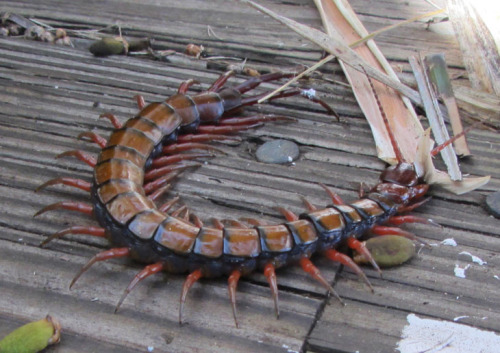 ↑ One of many large centipedes spotted on our porch. This one's about five inches long.
↑ One of many large centipedes spotted on our porch. This one's about five inches long.
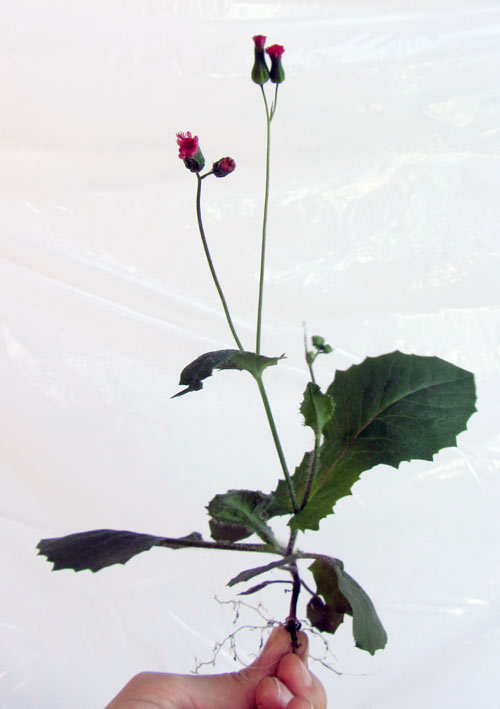 ↑ Many weeds were uprooted in search of the perfect silhouette.
↑ Many weeds were uprooted in search of the perfect silhouette.
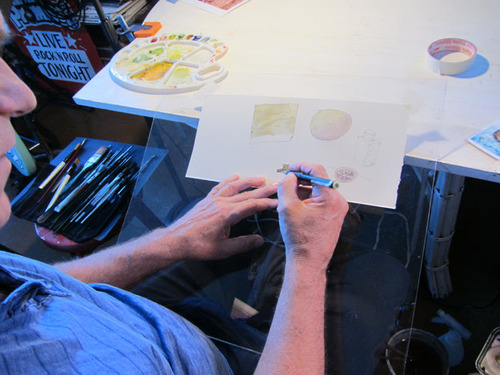 ↑ A watercolor lesson from Maui-based painter, Eddie Flotte.
↑ A watercolor lesson from Maui-based painter, Eddie Flotte.
There are a lot of artists on Maui; Lahaina town allegedly has more galleries per capita than any other town in the US. Among the many artists here, Eddie Flotte is the only one who paints a Maui that feels completely authentic to me.
Back in the early nineties, I used to occasionally pass Eddie and his easel on my walk home from elementary school. He'd be hard at work on a new plein air painting of Makawao town, and I'd silently peek over his shoulder. I had never seen an artist work before, and as a young kid that liked to draw, watching Eddie turn dark green globs of watercolor into sunlit trees was pure magic. Twenty-plus years later, I'm still a huge fan. Having no technical training with watercolor myself, I emailed to Eddie in hopes that he might let me pay a brief visit to his studio. Not only did he invite into his home for a look at his latest work, he sat me down for a three-hour impromptu painting lesson. I left fired up with whole new understanding of watercolor technique. It's rare that an encounter with an artist who I admire lives up to expectation, but Eddie's generosity and wisdom were as inspiring as his paintings.
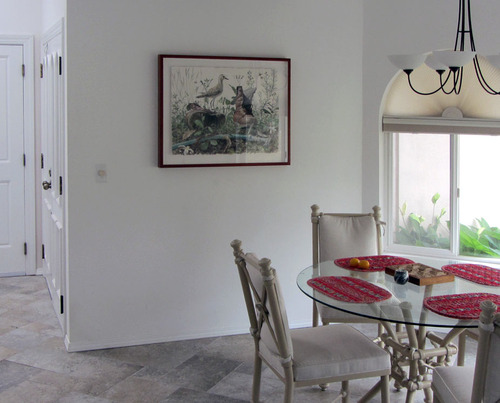 ↑ My parents' dinning room where the painting now hangs. From these windows, the Kolea can almost always be seen foraging from around October to May.
↑ My parents' dinning room where the painting now hangs. From these windows, the Kolea can almost always be seen foraging from around October to May.
 ↑ Float-mounting was another technique I picked up while working on this project.
↑ Float-mounting was another technique I picked up while working on this project.
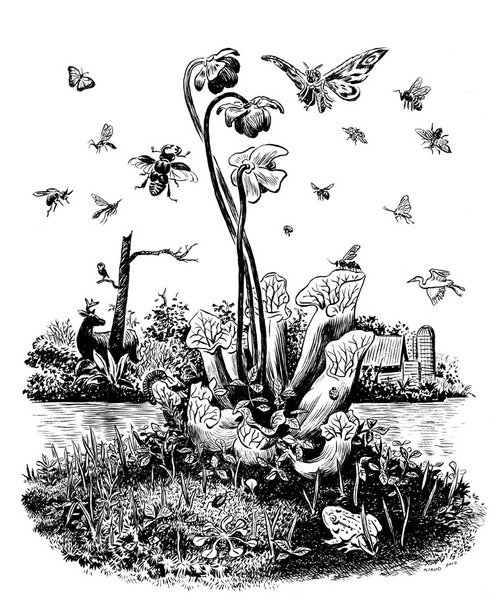 ↑ "Pitcher Plant," another Christmas gift in a similar vein. Yup, that's Mothra up top. I did this pen and ink drawing prior to the watercolor above, and it planted the seed for the Kolea piece. It was done for my good friend, Allison Maletz. She's an amazing watercolorist herself, and she did a gorgeous painting of my cat in exchange.
↑ "Pitcher Plant," another Christmas gift in a similar vein. Yup, that's Mothra up top. I did this pen and ink drawing prior to the watercolor above, and it planted the seed for the Kolea piece. It was done for my good friend, Allison Maletz. She's an amazing watercolorist herself, and she did a gorgeous painting of my cat in exchange.
I was just informed that the Illustrations below earned AARP magazine a Folio Ozzie award in the category,"Best Use of Illustration, Consumer above 250,000 Circulation" 2012.
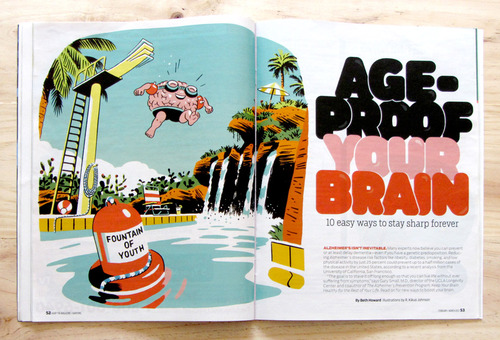 I have no idea what this means, but thanks!
I have no idea what this means, but thanks!
Feature illustrations for ESPN Magazine...
↑ Our newly reelected left-handed president.
 ↑ I'll probably never draw this guy again. ESPN Magazine.
↑ I'll probably never draw this guy again. ESPN Magazine.
Art Direction: Jason Lancaster
To celebrate its second return to press, here's a collection of sketches, production art, and notes from the making of The Shark King. Thank you to everyone who has contributed to the book's success!
↑ Rough style test for an unused book concept.
When Françoise Mouly approached me to do an early readers' comic for her Toon line, the first step was to sketch up a few loose concepts for possible books. One of my favorites followed a young pelican, Petey, through the northern Californian coast. Unfortunately for Petey, my sketchbook was promptly hijacked by the rascal who would eventually drive The Shark King.
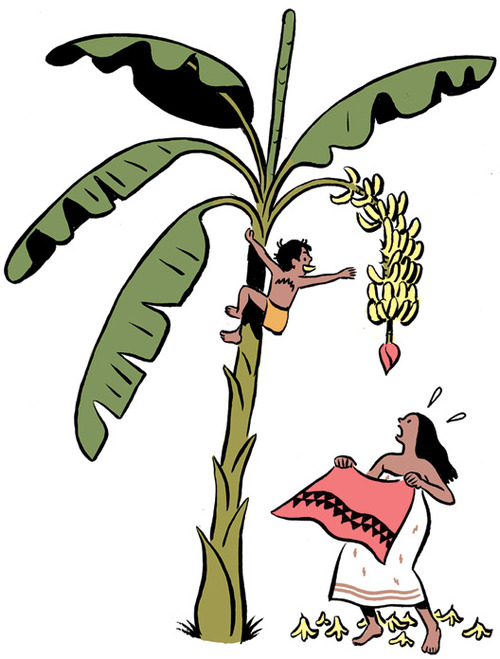 ↑ Nanaue and his mother, Kalei, in an unused vignette for the end papers of The Shark King.
↑ Nanaue and his mother, Kalei, in an unused vignette for the end papers of The Shark King.
I probably first came across Nanaue and his father, the shark-god Kamohoali'i, in elementary school. Rediscovering the mythology as an adult was a revelation. My interpretation in The Shark King tones down the violence of traditional versions in which Nanaue's insatiable appetite for meat compels him to dupe and devour passing fishermen. In some variations, he is ultimately butchered and cooked by villagers in retribution. Historians speculate that this story may have emerged to explain the terror of an ancient cannibal. Although brutal, the Nanaue myth has a strong emotional core in its protagonist, a young outcast searching for his place in the world.
The Shark King depicts ancient Hawaiians fishing with throw nets, fishing poles, and large hukilau (seine) nets. In my research, I learned that throw net fishing was introduced to Hawaii by Japanese migrants in the nineteenth century. Pole fishing began as an eighteenth century sport reserved for the ali'i (chief class). Of the three techniques illustrated, only the hukilau was likely practiced in ancient Hawaii.
Intricate lures, traps, spears, and a wide variety of nets were masterfully crafted and employed throughout ancient Polynesia. Early drafts of The Shark King included some of these tools, but their appearance was so unfamiliar, I ultimately decided that the space used to explain their function was better focused on Nanaue's struggle.
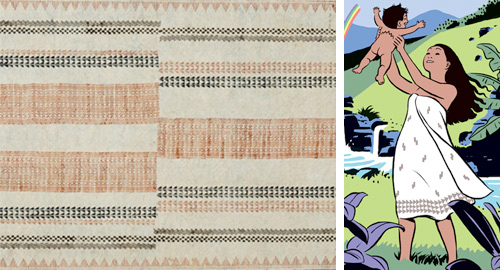 ↑ Barkcloth was produced throughout Polynesia, but Hawaiian kapa was renowned for its refined quality. Examples like this one inspired the patterns on Kalei's Pa'u (wraparound). From the collection of the Bishop Museum, Honolulu Hawaii.
↑ Barkcloth was produced throughout Polynesia, but Hawaiian kapa was renowned for its refined quality. Examples like this one inspired the patterns on Kalei's Pa'u (wraparound). From the collection of the Bishop Museum, Honolulu Hawaii.
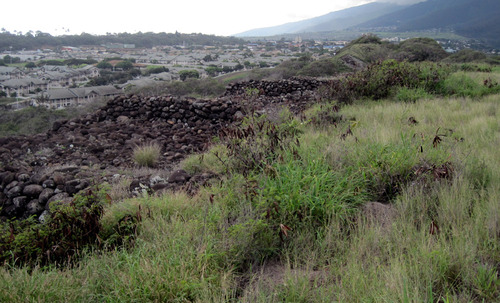 ↑ The ruins of an ancient Heiau (temple) complex overlooking sprawl in Waiehu, Maui. Invasive koa haole and other non-native plant species comprise the overgrowth. I took this photo on a research trip home. I grew up in the subdivision visible at the foot of the distant mountains in the upper right corner.
↑ The ruins of an ancient Heiau (temple) complex overlooking sprawl in Waiehu, Maui. Invasive koa haole and other non-native plant species comprise the overgrowth. I took this photo on a research trip home. I grew up in the subdivision visible at the foot of the distant mountains in the upper right corner.
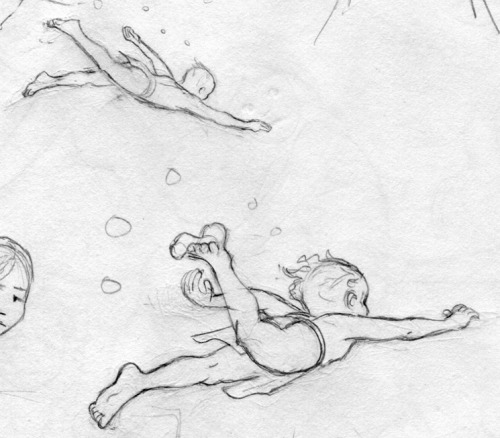 ↑ Sketchbook.
↑ Sketchbook.
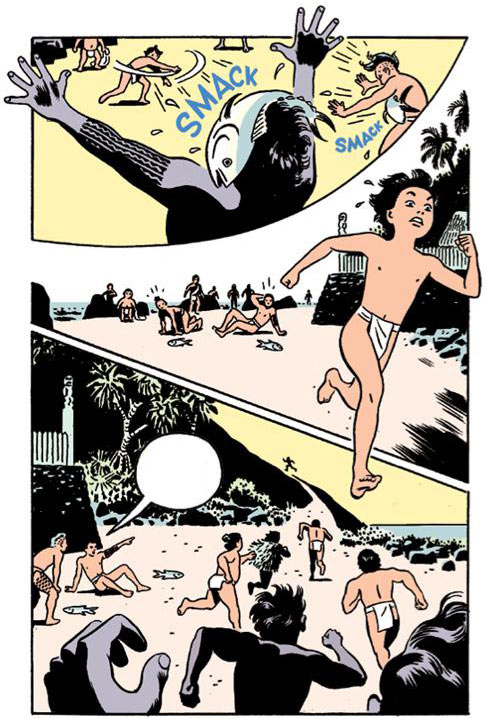
↑ Rejected style test for The Shark King. This looks more like a page from an 80s DC superhero comic than the kids book I had in mind.
↑ A more colorful and cartoony chase scene as it appears in The Shark King.
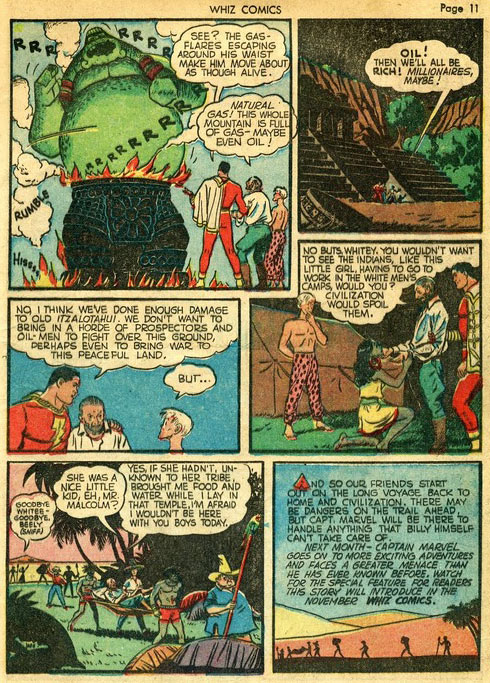 ↑ Whiz Comics #22 by C.C. Beck, 1941.
↑ Whiz Comics #22 by C.C. Beck, 1941.
While searching for a simple, direct, and colorful way to depict Nanaue's world, I returned often to the work of C.C. Beck. I'm always impressed by how much information he squeezed into his 1940s Captain Tootsie comic book ads without them ever feeling cramped. During his thirteen year stint illustrating Captain Marvel, Beck only wrote one 11-page story: 1941's "The Temple of Itzalotahui" (It's-a-lot-a-hooey). Although dated by cultural sensibilities, for me, this story is his best.
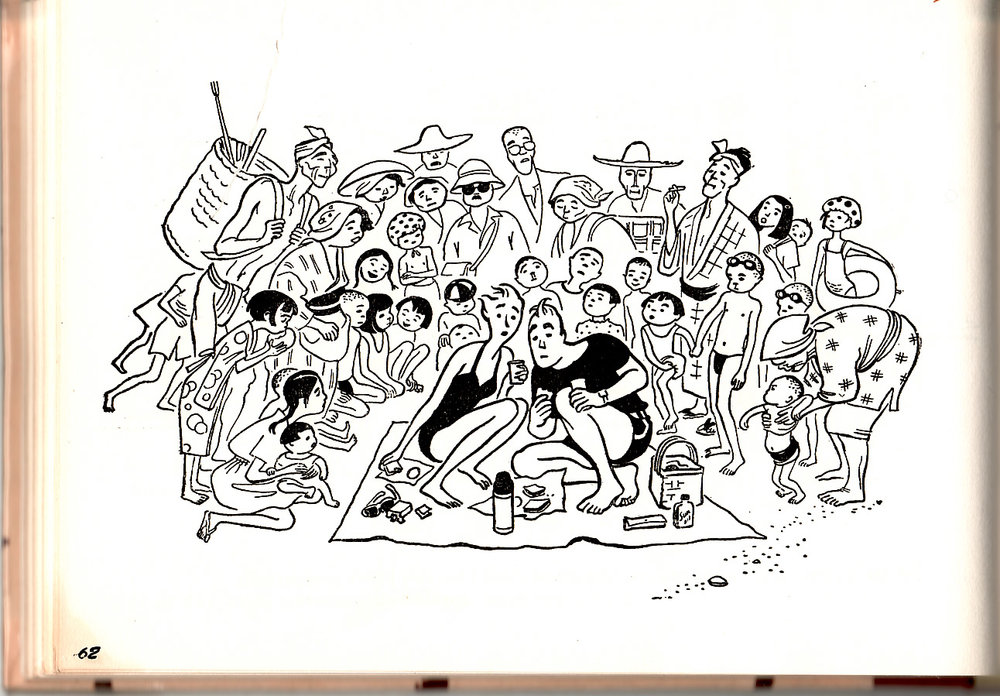 ↑ Anne Cleveland's elegant figure work in It's Better With Your Shoes Off, 1955, was another source of inspiration.
↑ Anne Cleveland's elegant figure work in It's Better With Your Shoes Off, 1955, was another source of inspiration.
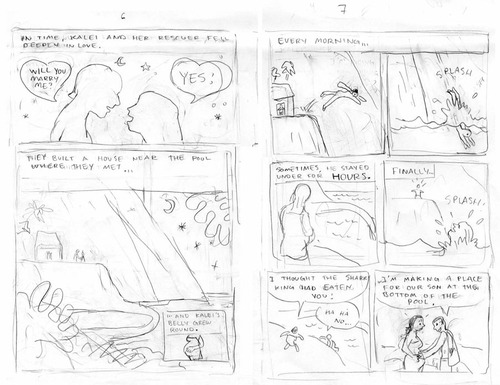 ↑ An early rough for pages 10 and 11. The entire book began as a loose cartoon manuscript and slowly tightened over the course of many subsequent sketch-drafts.
↑ An early rough for pages 10 and 11. The entire book began as a loose cartoon manuscript and slowly tightened over the course of many subsequent sketch-drafts.
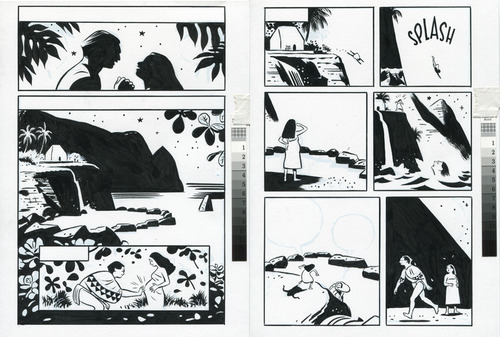 ↑ Raw scans of the finished pen and ink artwork.
↑ Raw scans of the finished pen and ink artwork.
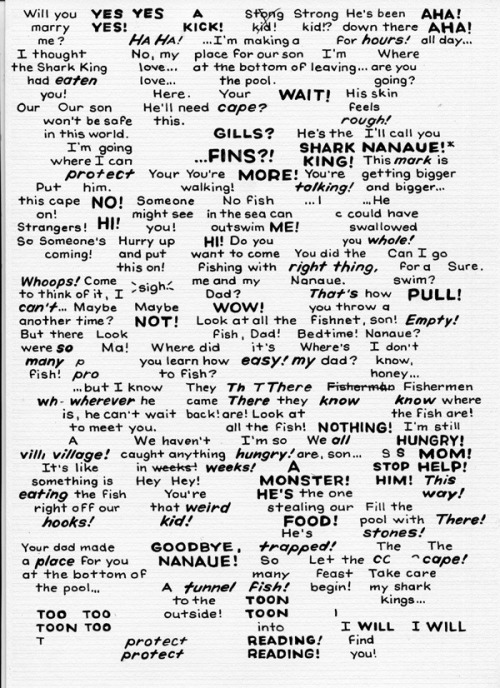 ↑ Hand lettering was done separately.
↑ Hand lettering was done separately.
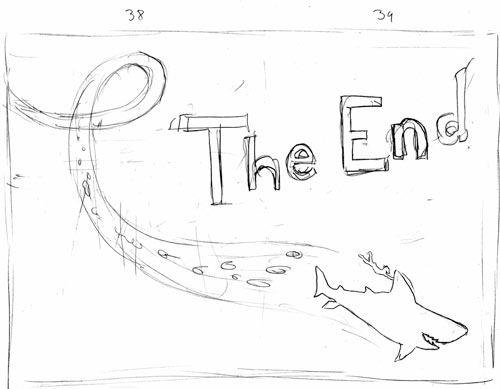
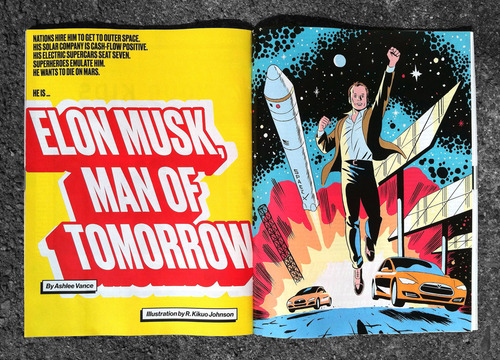 Feature Illustration for Bloomberg Businessweek.
Feature Illustration for Bloomberg Businessweek.
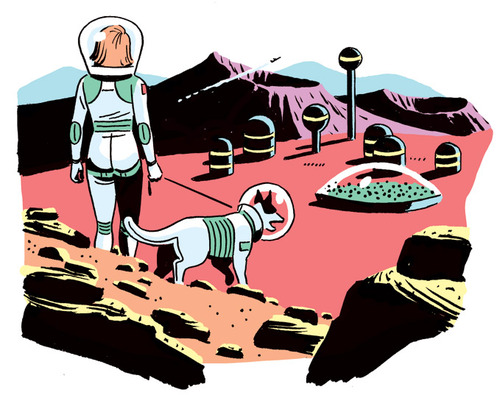 The article included 3 small spots imagining some of Musk's future innovations. I was thinking a lot about Wally Wood as I worked on these.
The article included 3 small spots imagining some of Musk's future innovations. I was thinking a lot about Wally Wood as I worked on these.
 An early sketch.
An early sketch.
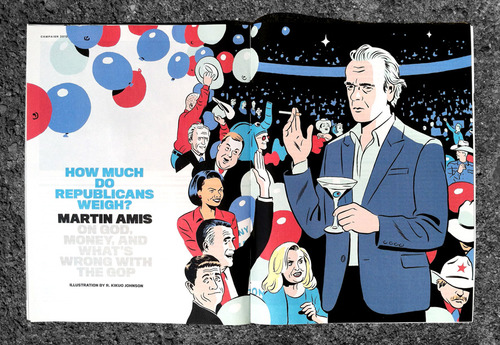 A feature by British novelist Martin Amis for Newsweek. I had less than a 48-hour deadline for this one: a day for sketches and a day for the final.
A feature by British novelist Martin Amis for Newsweek. I had less than a 48-hour deadline for this one: a day for sketches and a day for the final.